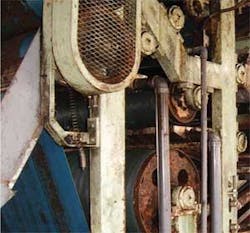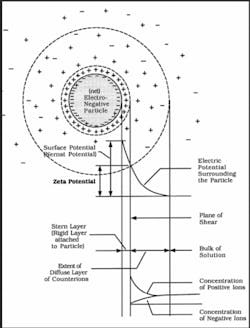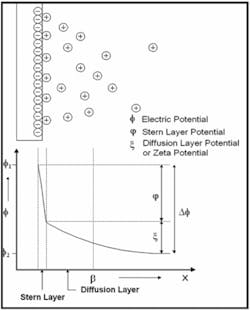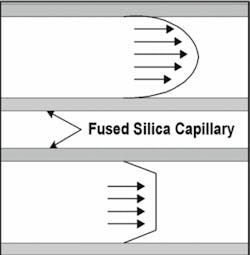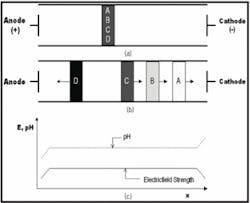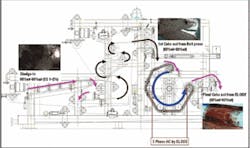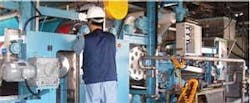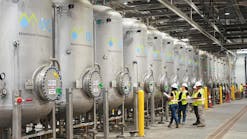By Hyunyoul Kim
An ACE Korea study looks at use of an electric-osmosis dehydrator to decrease sludge from wastewater and save on costs, too.
Sewage and wastewater treatment is essential to maintain clean aquatic environments, such as rivers and oceans. As for sludge produced by facilities that treat sewage and wastewater, many advanced countries have been reutilizing the sludge as an energy resource and have abandoned traditional treatment methods such as reclamation and ocean disposal. Until 2008, Korea relied on ocean dumping for disposal of over 70% of total sludge produced.
Ocean disposal, however, doesn’t only cause marine pollution, but is also difficult to manage. It has many problems due to the effect on oceanic life and regulation of ocean disposal by the 1972 London Convention on prevention of marine pollution by dumping of wastes and other matter. Therefore, sludge dehydration is an important alternative treatment process.
Old Belt Press Filter of K company’s wastewater treatment plant.
During the water treatment process, a considerable quantity of sludge is produced in a settling tank. This sludge is dehydrated by various processes. The dehydration method is roughly divided into natural and mechanical processes. Natural processes are further divided into sand drying and lagoon processes.
Mechanical processes, on the other had, are further divided into the vacuum filter process, using vacuum suction force, and the pressure filter press process, in which pressure is imposed on the filter layer — centrifuges using centrifugal force, belt press filters using compression pressure of the belt, and so forth.
During the dehydration process, overloading may occur due to the cake’s water content or distribution of size, density and mechanical intensity of sludge coming into the dehydration equipment.
Generally, the dehydrator can remove physically bounded water such as free water between sludge floc. The removal of this hydrogen bond or chemical bond must use special methods such as drying, i.e., evaporation or incineration.
Sludge drained from a settling tank during sewage and wastewater treatment has high organic content, so it often turns putrid and stinks when left alone for a long time — another challenge to overcome. The final step in sludge processing is removal of sludge with high concentration of organics (lowering the water content of sludge) by solid-liquid separation. The purpose of lowering the sludge’s water content is reducing the waste processing cost by decreasing the sludge volume/weight and reducing the initial investment and maintenance costs by downsizing the equipment used and increasing processing efficiency.
So far, most of the sewage and industrial wastewater sludge in Korea are disposed to the ocean or reclaimed together with general waste. Also, it can be used as ocean reclamation material, farmland molding material, or cement compound. It’s important to improve the dehydration rate of sludge and minimize water content percentage to minimize various problems inherent in sludge production. The electric osmosis dehydrator used in this research is known as a high efficiency sludge processing technology that produces sludge cake with a water content percentage lower than 60wt%. In this research, the sludge downsizing project of K company’s wastewater treatment plant (WWTP), having encountered difficulties in dehydration due to the high organic solid content, deploys the electric osmosis dehydrator.
Theory
Zeta potential — The surface electrokinetic characteristic of colloidal particles floating in liquid, zeta potential is used as the standard of surface electric attraction and repulsion force between floating materials or floating material and filter. When a colloidal particle comes in contact with ionic material, its surface becomes charged. Measured in millivolts (mV), this phenomenon occurs when the surface molecule is ionized due to the contact with ionized material or the particle receives ion of opposite parity and separated. The dispersion level and stability of the particle is determined by the surface charge of the colloidal particle, and the measurement of the zeta potential is made to control the dispersion level in many processes using colloidal particles. By controlling the zeta potential of colloidal particles, the dispersion level is increased by increasing the zeta potential in the field of paint, dispersant, paper and medicine. Conversely, the flocculation of particles is increased by decreasing the zeta potential in the field of wastewater treatment and flocculation process. Only a few mV of potential (0-±5 mV) is required for good coagulation or flocculation.
Figure 1 shows the concept of the “electrical double layer” and the ionic condition near the negatively charged particle and repulsion force in between particles. Initially, positive ions stick to the surface and form a Stern layer due to the attraction with negatively charged colloidal particles. With the formation of several layers, not only is the attraction force between colloidal particle and positive ion produced but also created is the repulsion force between the Stern layer and the positive ion and in between positive ions produced. As a result, the so-called “diffuse layer” made of positive ions is formed near the particle.
Figure 2. Small portion of electrical double-layer at the hydrosol interface.
As illustrated, this cation charge exists a lot on the particle surface but decreases farther away, and eventually goes in equilibrium with negative ions. The Stern layer and diffuse layer are called the electrical double layer. In liquid, negatively charged colloidal particles move to the positive electric pole in the external electric field, the zeta potential — which is the surface electrical characteristic of the particle — can be measured by measuring the velocity of the particle in the given electric field.
Electric osmosis dehydration — Electric osmosis is the most basic phenomenon of separation of all electrical forces in which electricity is applied to a mixture of solid and liquid. Figure 2 shows the electric double layer applied to hydrosol, which forms a Stern layer with high electrical charge and diffusion layer with low electrical charge near the particle. In case the electric double layer is not formed in the particle, flocculation occurs due to the Van der Waals force. But when electrical force is exerted near the particle, an electric double layer is formed resulting in a repulsion force between adjacent particles. The particle doesn’t move if the positive and negative electrodes are applied to the colloid, and electrical osmosis flow — liquid movement between particles — is observed. Figure 3 describes the liquid flow by electric osmosis compared to capillary flow by pressure.
Electrophoresis is the movement of electrically charged particles in an electric field in solution. Solid particles dispersed in the water have a positive charge, and if the positive electrode is applied, particles gather near the positive electrode. In case of hydrosol separation of colloidal particles in suspension in water, most particles have a negative charge, so if positive electrode is applied to the hydrosol, solid particles gather near the positive electrode, which accelerates the separation. In the absence of ions in a liquid or fine particle in oil (whose dielectric constant is larger than water), however, liquid-particle separation by electrophoresis and electric osmosis is impossible. Figure 4 shows solid particle movement by its surface characteristic and the change in hydrogen ions when positive and negative charges are applied to the solution containing solid particles (A, B, C, D). In the early stages of Figure 4 (a) solid particles (A, B, C) with a positive charge move to the negative electrode, whereas the solid particle (D) with a negative charge moves to the electrode. The moving velocity differs by each particle’s electrical mobility. And, as in Figure 4 (b) among the same kind of particles with positive charges, particle A with the largest mobility is closest to the negative electrode, whereas particle C with the smallest mobility is farthest from it. Figure 4 (c) shows the change in electrical field intensity and hydrogen ions due to the concentration of particles when particles move by electrophoresis.
Figure 5. Schematic diagram of Dehydration of Electro-osmosis Dehydrator (ELODE)
Principle and structure — Figure 5 shows the dehydration schematic diagram of the electrical osmosis dehydrator used in this research. This dehydrator is composed of a drum that supplies positive electricity, caterpillar that supplies negative electricity, carbon that supplies electricity to these electrodes, and a filter bag that prevents the sludge from breaking away as well as contact between positive and negative electrodes, and a washing machine for the filter bag after sludge dehydration is set. The drum as the positive electrode has a water cooling system to prevent damage by heat during dehydration. It’s cylindrical in shape with a 680-mm diameter and is made of titanium for effective electricity supply and corrosion resistance. The negative electrode is made by connecting 191 Palt Bar made of STS 316. The filter bag is made of 2-mm-thick polyester to improve dehydration efficiency. As shown in Figure 5, electrical osmosis dehydration’s principle is such that sludge dehydrated in the first dehydrator proceeds to the conveyor dehydrated during a single cycle of drum rotation and is put out.
Experiment and method
Treatment plant for experiment — In this research, K company’s sludge facility in Gimcheon City, Gyeongbuk, was used. Capacity of its WWTP is about 1,400 m3/d, and sludge produced after wastewater treatment is treated by a 2M grade belt press filter using cationic flocculant. The sludge produced is 30 tons/day, and water content percentage of the dehydrated cake was 86.7wt% on average. As shown in Figure 6, the belt press filter used so far was operated 24 hours a day, and it urgently needs a replacement as it has been in operation for over 15 years. In this project, the old belt press filter was removed and sludge reduction was attempted by installing the electrical osmosis dehydrator. The company’s sludge is analyzed in Table 1.
null
Installation and operation
In this research, the old belt press filter of K company’s WWTP was replaced and dehydration efficiency was compared after the installation of the BELO-type 2M grade electric osmosis dehydrator. Figure 7 shows the newly installed unit. The dehydrator of K company’s WWTP is a BELO-2000 model with a concentrated sludge treatment capacity of 18 m3/hr.
As shown in Figure 5, sludge was concentrated to 99wt% using polymer in the WWTP. The concentrated sludge is put into the electric osmosis dehydrator to apply the first pressurized dehydration using a four-stage compression roller. Water content percentage of the first pressurized dehydrated sludge was 89wt%. Finally, electric osmosis dehydration is applied.
Results
Before the electric osmosis dehydrator was installed, the water content percentage of the dehydrated sludge was 86.7wt% as shown in Table 2. The dehydrated sludge using the electric osmosis dehydrator, however, was 56.8wt% (see Figure 8). The sludge amount of K company was 900 tons/month before the installation of the dehydrator, this amount decreased to 277 tons/month (69.2% reduction) after the installation of the dehydrator. Sludge treatment cost was KRW70,000/ton [KRW1,000,000 = US$775.75]. By installing the electric osmosis dehydrator, the annual treatment cost of KRW750,000,000 was reduced to KRW230,000,000, entailing savings of over 70%.
null
Analysis of Operation Cost
The control panel of K company’s electric osmosis dehydrator can control all kinds of electrical motors up to 13 units, such as the mixing tank agitator, polymer pump and five units of dehydrator type electric motors such as the drive and washing motors in the WWTP. Power consumption of all 18 electrical motors is 52.2kw. Power consumption of the dehydrator, including these electric motors, is about 90kw. This means the power consumption of the dehydrator during operation is about 48kw and is very small compared with the reduction in sludge amount.
Conclusion
Water content percentage of sludge is a very important factor as it’s related to the sludge amount in the wastewater treatment process. The sludge dehydration rate is strongly influenced by organic matter content. The pressurized dehydrator showed many problems in dewatering sludge of high organic matter concentration with about 85wt% water content percentage. An electric osmosis dehydrator, however, demonstrated water content percentage of less than 60wt% in the dehydration of sludge with high organic matter content, enabling sludge reduction by over 50% due to improved water content percentage by over 20wt% compared with results of the previous pressurized dehydrator.
The electric osmosis dehydrator in K company’s wastewater treatment plant in this research can perform high-efficiency dehydration of less than 60wt% with the additional advantage of power consumption that’s lower than that of its predecessor, so it’s expected to bring about a significant economic advantage such as transportation cost savings, waste landfill reduction, drying and incineration, and so forth. WWi
Acknowledgment: The author would like to thank inventor Son Se-Inn and ACE Korea Inc. Co. Ltd., of Busan, Korea, for their assistance on this study. Contact: www.elode.co.kr
Author’s Note:
Hyunyoul Kim is with Samwoo Intech Co. Ltd., of Busan, Korea, and holds a master’s degree in engineering from South Korea’s Pusan National University. Contact: http://esamwoo.co.kr
